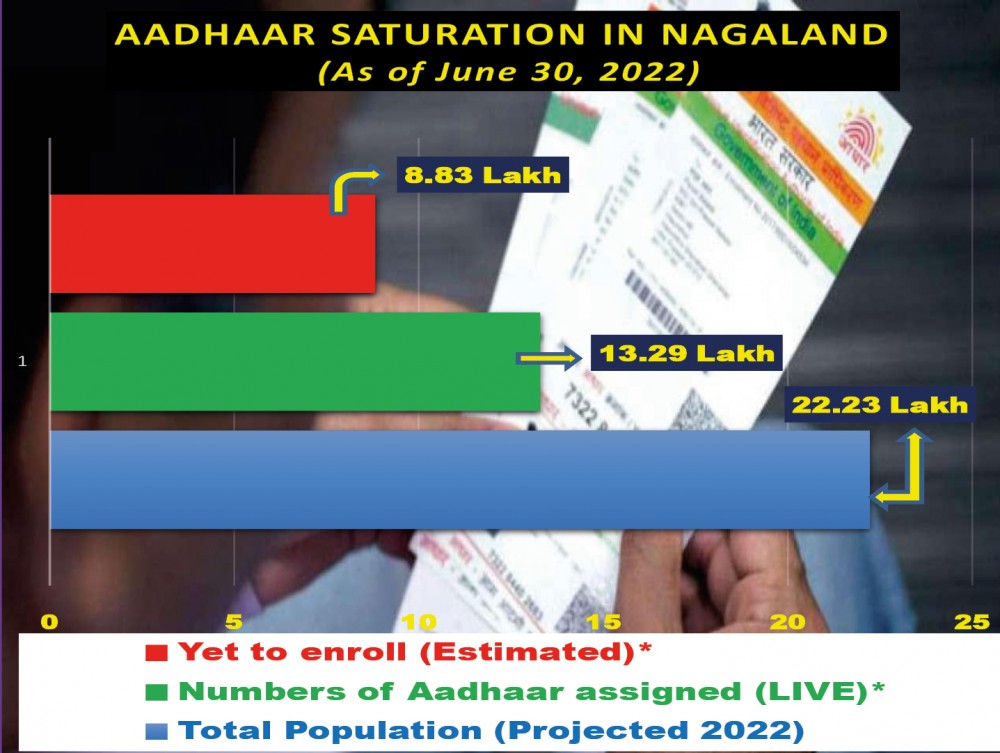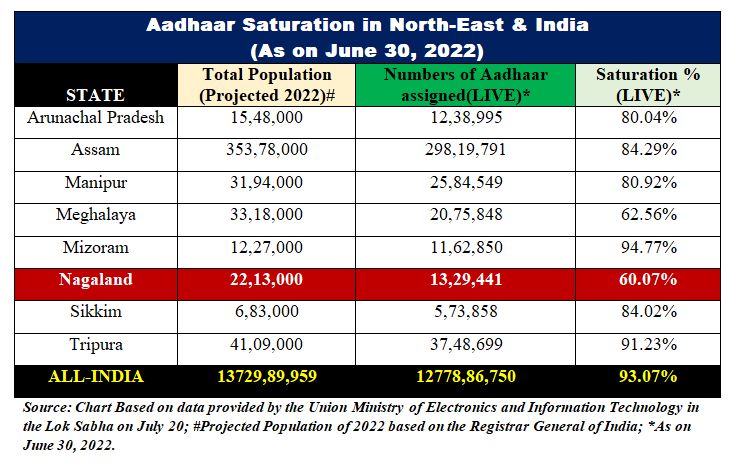Source: Chart Based on data provided by the Union Ministry of Electronics and Information Technology in the Lok Sabha on July 20; Projected Population of 2022 based on the Registrar General of India; *As on June 30, 2022.

Over 100% saturation in Dimapur, below 70% in most districts
Morung Express News
Dimapur | August 1
Nagaland has the lowest Aadhaar saturation in India and nearly 40% of the total projected population in 2022 are yet to be get their enrolment, according to official data by the Union Ministry of Electronics and Information Technology (MEITY) on July 20.
As per Registrar General of India (RGI) data, the State’s total population in 2022 is estimated at 22,13,000 and out of this, 13,29,441 have been assigned ‘Live Aadhaar’ cards, informed the data provided by the Minister of State MEITY, Rajeev Chandrasekhar in the Lok Sabha.
Accordingly, the state/union territory-wise Aadhaar Saturation details from the Unique Identification Authority of India (UIDAI) cited by the Minister highlighted that as of June 30, 2022, Nagaland’s Aadhaar’ saturation was 60.7%, the lowest in India. In absolute terms, a total of 8,83,559 persons were yet to enrol for Aadhaar as of June 30.
Meghalaya had the second lowest saturation at 62.56% and the UT of Ladakh was third at 78.32%.
It must be noted here that as of March 31, 2022, Meghalaya had the lowest Aadhaar saturation at 58.61% followed by Nagaland at 59.29%, but since then, the former had improved its enrolment.

Total enrolment of the entire projected population is indicative of 100% saturation.
As per the UDAI’s Aadhaar Dashboard on July 30, while saturation of Aadhaar cards is more than 100% in Dimapur (109%), the rest of the districts in Nagaland were lacking behind in enrolment with less than 50% in Peren and just in the half-way mark in Wokha (50%).
In terms of saturation, Kohima was second highest at 75%, followed by Tuensang and Longleng at 72% each. In the rest of the districts, the saturation was below 70%.
Meanwhile, Delhi, Goa, Himachal Pradesh, Lakshadweep, Punjab, Telangana has over 100% Aadhaar saturation, while the UT of Lakshadweep is leading at107.60%, followed by Delhi (106.97%) and Himachal Pradesh (102.66%).
As per RGI data, the total projected population (2022) of India was 137.30 crore and as on June 30, a total of 133.586 crore Aadhaar cards have been generated, the Minister informed.
However, the actual number of Aadhaar holders would be lesser due to deaths. Hence, the concept of “Live Aadhaar” has been introduced to estimate the number of persons holding Aadhaar who are alive, he added.
It is estimated that the number of Live Aadhaars stands at 127.79 crore and based on this, it can be concluded that a population of around 9.51 crore are yet to enrol for Aadhaar, out of which 8.30 crore are children in the age group of 0-5 years, the Minister added. It translates to 93.07% of the total projected population.
Meanwhile, Chandrasekhar maintained that the UIDAI is making all out efforts for covering the left-out population for Aadhaar and the same is evident from the fact that around 57,000 Aadhaar counters were operational throughout India as on as on June 30, 2022.
In addition, nearly 34,000 Mobile/Tablet based Child Enrolment Lite Client (CELC) are also functional specially for carrying out Aadhaar enrolment of children in 0-5 age group, he added.
Every person who has approached UIDAI has been issued Aadhaar irrespective of resident not having hands or clear fingerprints, he maintained, adding that the provision is made in Regulation 6(1) of the Aadhaar (Enrolment & Update) Regulations, 2016, which stated that: “For residents who are unable to provide fingerprints, owning to reasons such as injury, deformities, amputation of the fingers/ hands or any other relevant reason, only Iris scans of such residents will be collected.”
The above information as well as Biometric Exception Guidelines are available in the public domain on the official website of UIDAI, for the reference of the public, he added.






